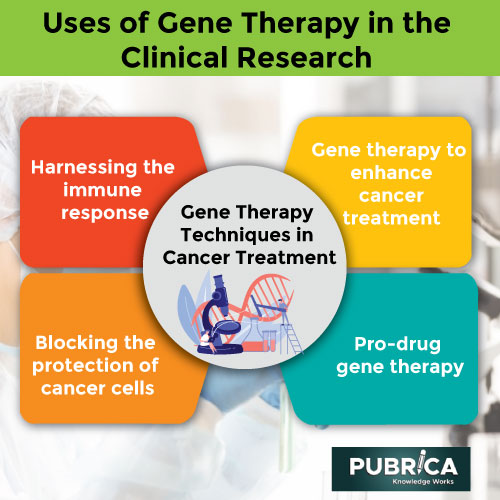
Current developments in bioinformatics and computational biology: A Systematic Review
March 5, 2021
Effective strategies to monitor clinical risks using biostatistics
March 9, 2021In-Brief
- Certain types of gene therapy help in improving the body’s ability to recognize and destroy cancer cells. Certain immune system cells are responsible for recognizing and killing these cells
- Certain types of gene therapy help in improving the body’s ability to recognize and destroy cancer cells. Certain immune system cells are responsible for recognizing and killing these cells
Introduction
Gene therapy is the process of altering the genes in your body’s cells to cure or prevent disease. Your DNA — the code that governs all of your body’s structure and function, from making you taller to controlling your body systems — is stored in your genes. The disease caused by genes that aren’t working properly.
Gene therapy is a treatment that comprises altering the genes in your body’s cells to treat or prevent disease. Your genes store your DNA, which is the code that controls all of the structure and function of your body, from making you taller to regulating your body systems. Genes that aren’t functioning properly can cause disease.
Why it’s done
Your genes store your DNA, which is the code that controls all of the structure and function of your body, from making you taller to regulating your body systems. Genes that aren’t functioning properly can cause disease research paper writing help in understanding the concept of gene therapy in detail.
- Replacing mutated genes. Since some genes function incorrectly or no longer function at all, certain cells become diseased. Replacement of defective genes can aid in the treatment of certain diseases. A gene called p53, for example, usually prevents tumour development. Problems with the p53 gene linked to a variety of cancers. If doctors could substitute the cancer cells’ faulty p53 gene, the cancer cells would die.
- Fixing mutated genes. Mutated genes that cause disease switched off to stop promoting disease, or stable genes that help avoid disease c turned on to stop the disease from spreading.
- Constructing diseased cells more evident to the immune system. Since your immune system doesn’t identify diseased cells as intruders in some cases, it doesn’t attack them. Specialists were able to use gene therapy to teach the immune system to recognize dangerous cells.

Types of Gene therapy
There are two elementary types of gene therapy: germline therapy and somatic gene therapy.
Germline therapy
This treatment entails altering the genes inside germ cells (sperm or ova). These gamete cells merge to form a zygote during reproduction, which divides and passes the modified gene on to all other cells in the body during offspring growth. As a result, the treatment changes the genome of future generations.
While germline therapy can treat genetic diseases, jurisdictions in countries such as Switzerland, Australia, and Germany have excluded its use due to concerns about unknown risks and long-term effects on future generations. Furthermore, the treatment is prohibitively expensive.
Somatic gene therapy
Somatic gene therapy, unlike germline therapy, requires inserting therapeutic DNA into body cells rather than germ cells or gametes. It ensures that the therapy’s results are limited to the person receiving treatment. Clinical development services helps in drug Improvement, is a comprehensive term used to define the whole process of creatinga new drug or device to the market. It comprises drug discovery / product development, pre-clinical research (microorganisms/animals) and clinical trials (on humans).
Fewer ethical problems enclose the field of somatic gene therapy compared with germline gene therapy, even though the therapeutic solution is still in its early stages of development and susceptible to challenges.
The first hurdle is effective integration into the genome; if the changed gene integrated into the wrong part of the DNA, the disease can be induced rather than prevented. The second step is to ensure the target gene. Finally, gene expression helps in avoiding disease-causing overexpression.
Inserting genes into cancer cells
Inserting genes into cancer cells is one of the most difficult aspects of gene therapy, and researchers are working to advance new and better methods for doing so. One of the most common ways to do this is to use a vector to deliver a gene to a cancer cell. Viruses are generally used as vectors because to target and enter cells to deliver their genetic material once within. Scientists have devised modifying these viruses to only deliver genes to cancer cells and not to healthy cells. Other vectors, such as inactivated bacteria, are also being investigated. Many Clinical writing services provide in-depth knowledge about the gene therapy concept.
Gene therapy techniques in cancer treatment
Some of the techniques used in gene therapy to treat cancer are,
Harnessing the immune response
Some types of gene therapy help in improving the body’s ability to recognize and destroy cancer cells. Certain immune system cells are responsible for recognizing and killing these cells. Certain genes are added to a patient’s immune cells to enhance their ability to recognize and destroy cancer cells. These methods used in a few trials around the United Kingdom.
Gene therapy to enhance cancer treatment
Some techniques introduce genes into cancer cells that make them more susceptible to radiotherapy or chemotherapy, increasing these treatments’ efficacy.
Multiple clinical studies reported successful treatments for paediatric patients. The plan of gene therapy vectors and their clinical expansion are advancing rapidly. Research in that particular field will add an advantage to the researchers. Many research paper writing services online provide help with research writing to understand the concept’s depth and help increase the research work scope.
Blocking the protection of cancer cells
Gene therapy used to block some of the pathways that cancer cells use to survive. Apoptosis, for example, is a form of programmed cell death that occurs when a cell’s DNA is damaged and unable to be repaired. In cancer cells, apoptosis stops and then the cells split to form brand new cells that also encompass the damaged DNA. Researchers conduct much clinical medicine research to treat cancer. Some gene therapy techniques plan to prevent this inhibition of apoptosis to ensure that the cancer cells do die rather than survive.
Pro-drug gene therapy
Certain gene therapy techniques introduce genes into cancer cells that enable a pro-drug must convert into an active form—the pro-drug after the transforming gene given in the form of a tablet or capsule. The pro-drug is harmless to healthy cells, but it only enters cancer cells, regulating the gene and becoming harmful.
Conclusion
The benefits of gene therapy are greater than their drawbacks. The technique’s benefit is that it allows someone born with a genetic disorder or develops cancer to live everyday life. It is a benefit that greatly outweighs all of the disadvantages raised in opposition to gene therapy.
Many people, I believe, would change their minds if scientists educated our society. People who reject this technique, in my opinion, would change their minds if they have cancer or an infant born with a genetic disorder. These sceptics would prefer gene therapy if it meant saving the life of a loved one. Gene therapy can play a critical role in the lives of many people in the future. Conclude that people are resistant to gene therapy because it is unfamiliar and frightening to them. People are afraid because they don’t understand how to use the technique.
References
- Miller, A. D. (1992). Human gene therapy comes of age. nature, 357(6378), 455-460.
- Ginn, S. L., Alexander, I. E., Edelstein, M. L., Abedi, M. R., & Wixon, J. (2013). Gene therapy clinical trials worldwide to 2012–an update. The journal of gene medicine, 15(2), 65-77.



